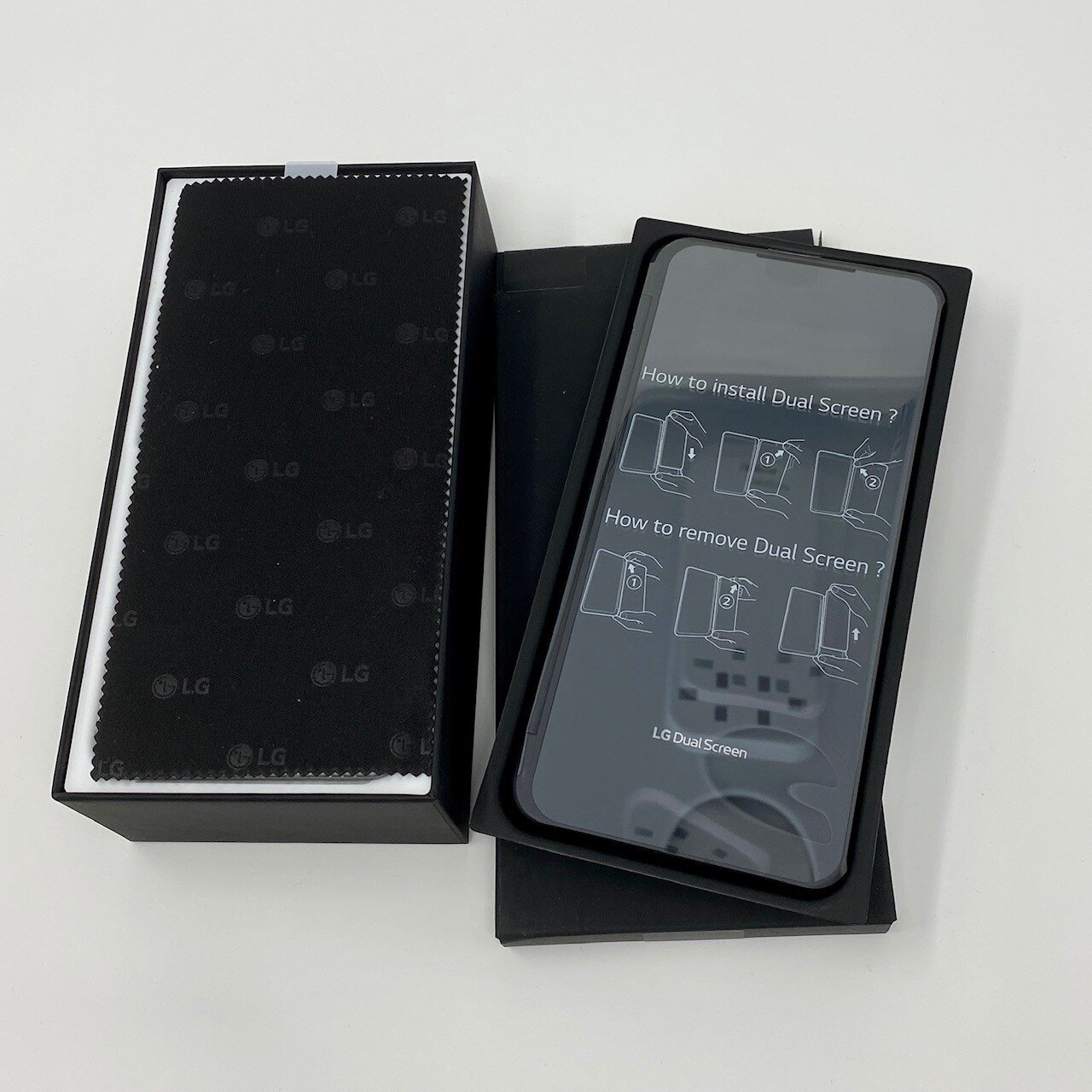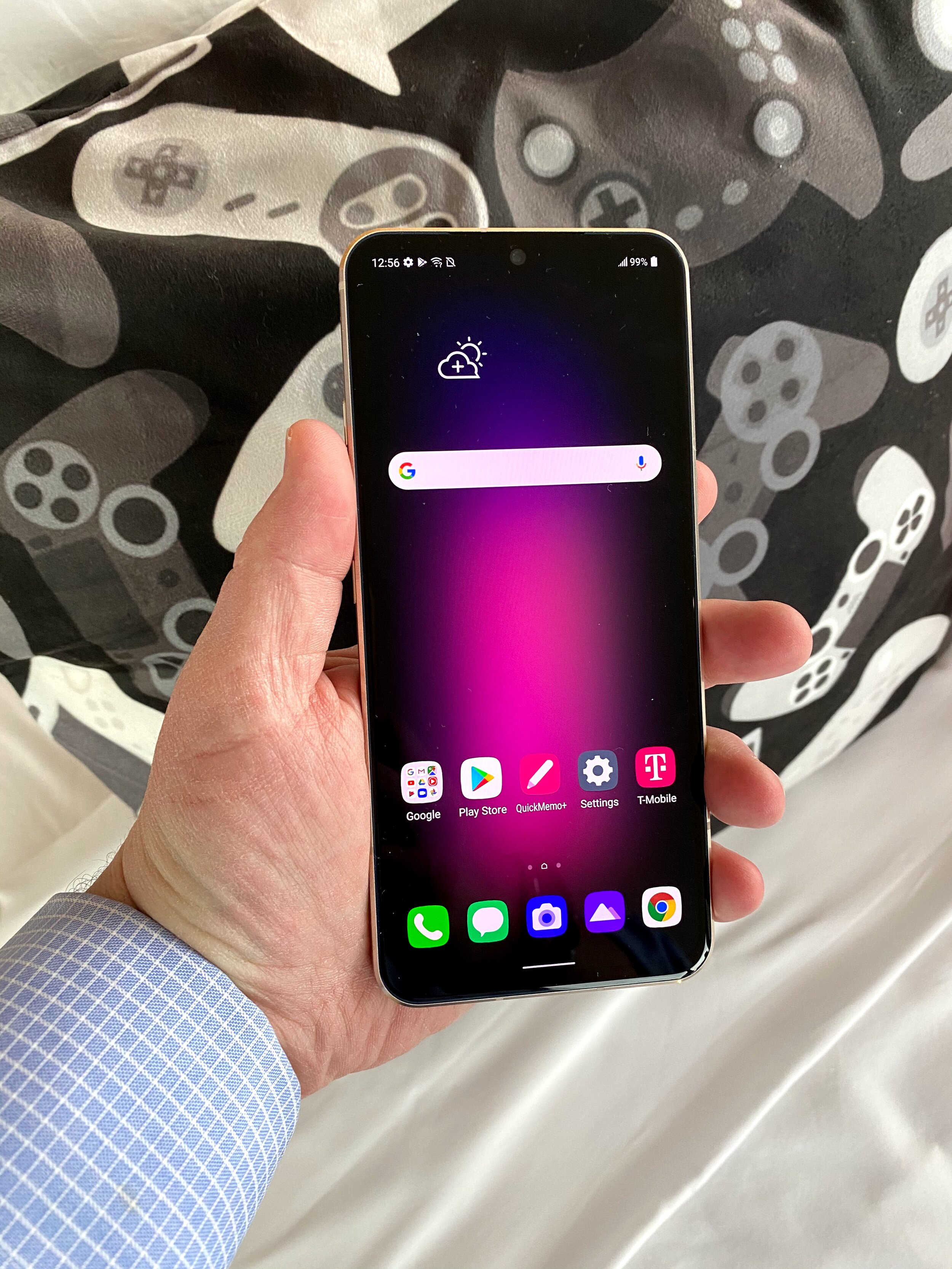Updated: LG Doubles Down on its Dual Screen Strategy with V60 ThinQ 5G
Bottom Line
LG makes good phones that struggle to compete against even-more-refined devices from Samsung and Apple. The V60 ThinQ 5G does stand out for the Dual Screen accessory, which is a gimmick that makes an already extremely large phone downright clunky. That said, LG is pricing the V60 aggressively and the Dual Screen helps the V60 stand out at retail.
[Report originally published 2/27/30; updated 3/19/20 with additional competitive information and unboxing/size comparison photos after pricing was announced and we got a review unit in.]
Why the V60 ThinQ 5G is Not a Folding Phone
LG is one of the leading manufacturers of flexible OLED displays. The fact that LG has chosen to sell rollable televisions and not foldable phones reflects LG’s assessment that the technology is not ready for mass consumer adoption in smartphones. Today’s folding phones are expensive, difficult to produce in volume, and require significant usability and durability tradeoffs. While we are impressed with Samsung’s Galaxy Z Flip after two weeks and have had no problems with our Galaxy Fold after four months, LG’s conclusion is entirely reasonable. Apple is also sitting out the folding experimentation stage – at least outside of its labs.
However, LG does want to offer something to stand out in the market that looks like a folding phone and provides additional functionality for specific use cases. To that end, LG launched the Dual Screen case for the V50 ThinQ in Korea early last year and followed it up with a more capable and widely distributed Dual Screen case for the 8X ThinQ a few months later. Techsponential has had an LG 8X with Dual Screen case since then and have found it to be more frustrating than useful. A brief hands-on period with the V60 ThinQ 5G in a Dual Case at LG’s preview event did not change my opinion (we will be getting a review unit for a longer-term trial). As Microsoft enters the market with a dual screen phone later this year, it will be interesting to see if it, LG, or Google, can make some of these use cases workable. In the meantime:
Having two screens makes multitasking easier, and apps that support a folder list on the left and content on the right are more useful. However, LG’s setup is unbalanced, making it hard to hold, and typing on the bottom of either of the displays is basically impossible because one of your thumbs just won’t reach the keyboard on the other side.
Flipping the unit around horizontally and using the bottom display as a keyboard looks adorable, but the typing experience is not great. Your new mini-laptop’s keyboard is too cramped to do anything other than hunt and peck.
Having a single app span both displays does not work well on the Dual Screen given the large bezels in between.
Watching video on the second display (horizontally) and using the main display as a kickstand works well, especially on airplane tray tables. However, thinner cases with kickstands or even a Popsocket solve this problem more elegantly.
Gaming with the bottom display configured as a controller is the one use case where the Dual Screen really shines.
LG has made some software improvements for the Dual Screen on the V60 ThinQ 5G – more apps span both displays – but the hardware has actually taken a step backwards. It is now harder to remove the phone from the case, which is a problem because when the V60 ThinQ 5G is in the Dual Screen case is can be difficult to use as a phone. The V60 ThinQ 5G is 77.6mm wide all by itself, which is bigger than even Samsung’s 73.7mm wide Galaxy S20 Ultra. The Dual Screen adds 8.5mm millimeters to that – for a hand-busting 86mm – and turns the V60’s nicely rounded corners into an uncomfortable rectangular slab when the second display is folded around back out of the way.
The V60 ThinQ 5G is a Solid Phablet, With Caveats
LG ticks off most of the boxes for a premium smartphone in 2020 with the V60 ThinQ 5G – it has the latest Qualcomm processor, an enormous high-resolution display, multiple cameras, and an oversized battery. It should be available at most major carriers in Western markets, including AT&T, T-Mobile, U.S. Cellular and Verizon in the U.S. However, LG does not have the same brand loyalty as Samsung or Apple, and LG has been forced to lower pricing on its past flagship phones shortly after launch. That will likely be the case this time as well.
Consumers have embraced supersized phones, but Apple and Samsung offer their premium products in a range of sizes, while the V60 ThinQ 5G comes in just a single size: gigantic. Without dimensional context, the V60’s 6.8” P-OLED display seems to fit between Samsung’s 6.7” Galaxy S20+ and 6.9” Galaxy S20 Ultra. However, the aspect ratios (shape of the screen rectangle) are different. The LG V60 ThinQ 5G’s case is both wider and taller than Samsung’s Galaxy S20 Ultra. The LG is comparable in width to Apple’s iPhone 11 Pro Max, but over 11mm taller. Even when it is not ensconced in the Dual Screen accessory, the V60 ThinQ Pro will simply be too big for many hands and pockets. In fact, the only phone I have on hand that is larger is Huawei’s Mate 20 X, a 7” phablet that was never sold in the U.S.
The V60 ThinQ 5G also lacks some features compared to some competitors. Unlike Samsung’s Galaxy S20 family or OnePlus’ flagship phones from 2019, LG does not offer a smoother 90 Hz or 120 Hz refresh rate for its display.
LG is using Qualcomm’s best Snapdragon 865 processor, but it is enabling mmWave 5G only on the Verizon variant. That means that AT&T and T-Mobile have incentives to push alternatives that support their full “layer cake” networks. Practically speaking, this won’t matter at all for consumers in Europe or Asia, and even most U.S. consumers won’t see any difference in the short term. It does support the 2.5 GHz 5G network that T-Mobile will be launching using Sprint assets. However, it could be an issue for consumers seeking assurance that their investment is future-proof.
Even with the large display and 5G, battery life is a highlight of the phone thanks to a mammoth 5,000 mAh battery.
Nobody has ever bought a phone because it offered the best audio quality, but LG’s audio features are a standout feature of the phone. LG is including 4 microphones tuned for capturing the human voice. On the playback side, LG’s 3D sound engine – similar to what is found on some LG TVs – adjusts the virtual surround mode in use based on content: voice, music, or sound effects. Finally, LG is one of the last holdouts offering a proper 3.5mm headphone jack, driven by a quad-DAC that provides superb audio quality to wired headphones. LG is pitching this as a gaming feature, and perhaps it will uniquely appeal to gamers, but it will be appreciated even more by audiophiles with investments in expensive headphones and in-ear monitors.
Historically, LG’s camera modules have been good, but not competitive with the best from Apple, Google, and Huawei. That is unlikely to change in this round. The V60 ThinQ 5G can record video in 8K/26fps, but LG opted not to include a zoom lens option. LG has offered phones with telephoto lenses in the past – it promoted the V40 ThinQ as the first “five camera” phone – but opted for a time of flight camera on the V60 ThinQ 5G instead, likely to keep costs down.
Instead, LG claims that the 64 MP sensor allows for such high resolution that you can crop to zoom instead. I briefly tested this hypothesis on the prototype we got hands on with, and came away unimpressed. On identical pictures of Manhattan’s skyline, cropping to zoom on LG’s 64 MP sensor produced worse results than the iPhone 11 Pro’s 3x optical zoom. It should be expected to fall even farther short of Samsung’s Galaxy S20 Ultra’s 10x hybrid periscope zoom, though the Ultra is in a different price category.
Pricing and Competition
LG originally promised that the V60 ThinQ 5G would come in “under $1000,” but that turns out to have been just an understatement. Verizon has the most expensive variant, at $949, which supports the carrier’s mmWave 5G network and includes the Dual Screen accessory. AT&T and T-Mobile have versions that lack mmWave capabilities, but support their sub-6 networks (in the case of T-Mobile, that will include its 600 MHz 5G network and Sprint’s 2.5GHz 5G assets it will own after the merger). Both AT&T and T-Mobile are offering the phone and Dual Screen accessory as a bundle for $899, and T-Mobile is also selling the phone on its own for $799. This pricing undercuts Samsung’s least expensive Galaxy S20 by as much as $200. Both use Qualcomm’s highest end Snapdragon 865 processor. The S20 has a higher refresh rate display and is easier to hold, but even leaving aside the Dual Screen, the V60 ThinQ 5G will be an instant bargain for performance-minded consumers who want the biggest display for the buck and are willing to trade size for increased battery capacity. LG’s phones also often drop in price over time faster than Samsung — and much faster than Apple — so the pricing advantage will likely get bigger over time. Unfortunately, while the value is there, LG’s brand is not as strong as Samsung. LG will need to rely on pricing and discounts to generate sales.
Conclusion
LG’s Dual Screen is a sweetener at retail, but not a core reason for consumers to buy. The V60 ThinQ 5G will sell based on whether consumers exclusively want enormous phones, are willing to make a few tradeoffs in the camera and display, and feel priced out by Samsung’s decision to start its Galaxy S20 line at $1000.
To discuss the implications of this report on your business, product, or investment strategies, contact Avi at avi@techsponential.com or +1 (201) 677-8284.















